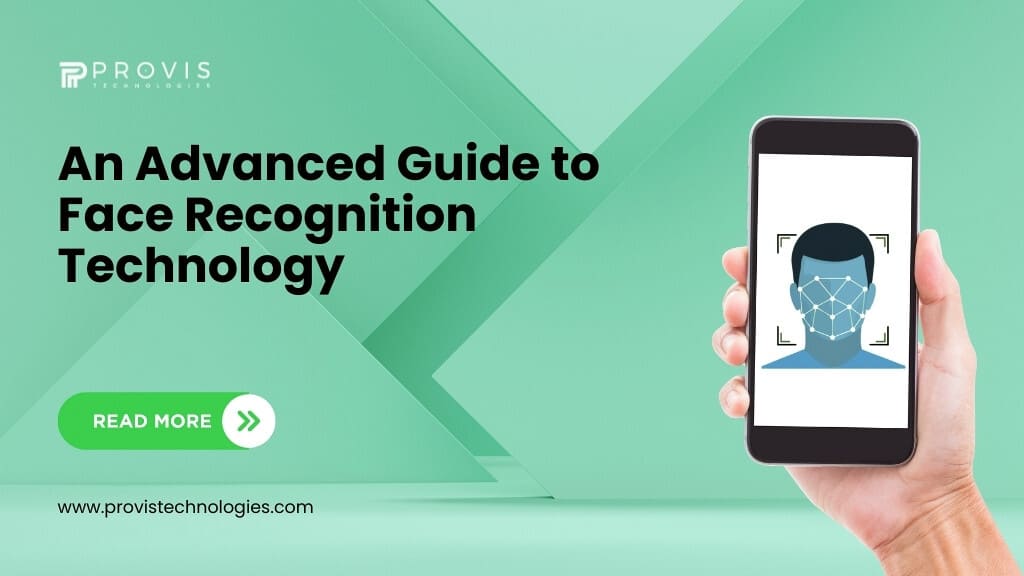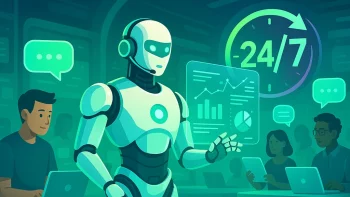Face recognition technology has become an essential part of our daily lives. Sectors like banking, security, social media, IT, corporate, etc., use it widely. Face recognition is a sophisticated process involving complex algorithms & technology. Today, we will take you through the essentials of face recognition technology. We will also explain how it works and what benefits, challenges, and future trends it has – all in detail.
What is Face Recognition Technology?
Face recognition technology is a biometric software application capable of uniquely identifying or verifying a person by comparing & analyzing patterns based on facial features. Unlike other biometric systems like fingerprint recognition, face recognition uses the most common and easy-to-access biological feature – the face.
How Does Face Recognition Technology Work?
The face recognition system works through several steps – each involves complex processes. They are given below.
Read More: Android vs iOS Which is the Best Platform for App Development?
Image Capture
The first step in the face recognition process is capturing an image of the face. This is done using a camera on a smartphone, a CCTV system, or any other digital device capable of taking pictures or videos.
Face Detection
Once the image is captured, the system needs to detect the presence of a face within the image. It distinguishes the face from the background and other objects. This facial recognition software uses algorithms like Haar Cascades or deep learning models such as Convolutional Neural Networks (CNNs) for face detection.
Feature Extraction
After detecting the face, the next step is to extract distinct features. The face detection system identifies primary points on the face, like the distance between the eyes, the shape of the jawline, and the contours of the nose and mouth. These points are known as landmarks. The face scanner saves these features.
Face Matching
The extracted features are then compared to a database of known faces. The system calculates the similarity between the captured face and the stored images. This is done using algorithms that measure the distance between feature points or by using neural networks to analyze patterns.
Decision Making
Finally, the face recognition technology decides whether the captured face matches any of the faces in the database. If a match is found, the identity is verified – otherwise, it is denied.
Read More: Color Palette Generators for Website
Face Recognition Technology Applications
Facial recognition software has a wide range of applications across various fields – read below:
Security & Surveillance
One of the most common uses of face recognition cameras is in the security & surveillance sector. It is used in airports, public places, and border controls to identify criminals, missing persons, and suspects.
Personal Devices
Smartphones & laptops often use face recognition apps to unlock devices. It provides an extra layer of security, which is better than traditional passwords.
Banking & Payments
Some banks and financial institutions use face recognition software to authenticate users during transactions. This is done to provide a secure banking experience.
Social Media
Platforms like Facebook use technology face recognition to tag people in photos automatically. This feature helps increase user experience by making it easier for users to do posts.
Healthcare
In healthcare, a face recognition system can help identify patients to be sure that medical records are correctly matched to the right individual.
Read More: Why is 2024 a Great Year to Start Your E-commerce?
Retail & Marketing
Retailers use face recognition to analyze customer behavior, improve customer service, and personalize marketing efforts based on customer preferences and purchase history.
Face Recognition Technology Benefits
AI face recognition apps can have a heap of benefits, such as:
Convenience
Unlike passwords or PINs, which are hard to manage and can be forgotten – face recognition service provides a convenient way to access devices. It relies on a person’s face, which is always available.
Security
Face recognition software adds a layer of security, which makes it difficult for unauthorized individuals to access secure areas. It is harder to fake or copy a face than other identification methods.
Non-intrusive
Face recognition can be performed from a distance without physical contact, which makes it a non-intrusive identification method. This is particularly useful in public places or situations where physical interaction is not feasible.
Must Read: The Future of E-commerce: Embracing SaaS Solutions
Speed
Face recognition systems can quickly identify individuals. This makes the process much faster. For instance, it is used at boarding flights, accessing secure areas, or verifying identities – speed is required in all these areas.
Face Recognition Technology Challenges
Despite its advantages, face recognition technology also faces several challenges:
Privacy Concerns
The use of face recognition technology raises significant privacy issues. There are concerns about how facial data is collected, stored, and used. And whether individuals are being monitored without their consent.
Accuracy & Biasness
Face recognition systems are not always accurate. They can sometimes fail to recognize faces or, worse, misidentify individuals. There have also been instances where the technology has shown bias – being less accurate in identifying people of certain ethnicities or genders.
Data Security
The security of the facial data stored in databases is a critical concern. If this data is compromised, it can lead to identity theft and other security breaches.
Read More: 10 Essential Tips for Launching Your E-commerce Journey with WooCommerce
Legal & Ethical Issues
The deployment of face recognition technology involves legal & ethical considerations. Regulations around biometric data use are still evolving. There is ongoing debate about the implications of widespread surveillance.
Face Recognition Technology Future Trends
The face recognition system is continually evolving. Here are some trends that might shape its future:
Improved Accuracy
Advancements in artificial intelligence and machine learning are expected to improve the accuracy of face recognition systems. It is believed that AI face recognition scanners can reduce errors & biases.
Read More: A Step-by-Step Guide to Website Optimization Strategies for 2024
Integration with Other Technologies
Face recognition cameras can be integrated with other biometric systems, like voice recognition & fingerprint scanning. This can enhance security and provide multi-factor authentication.
Wider Adoption
As the technology becomes more accurate & affordable – its adoption is expected to increase across various sectors, including retail, healthcare, and banking.
Better Privacy
With growing awareness of privacy concerns, future face liveness detection systems will likely incorporate robust privacy measures, like data encryption & anonymization.
Real-time Recognition
Advances in processing power and network speeds will enable real-time face recognition. It will allow instant identification & verification in various applications.
How to Leverage Face Recognition Technology?
There are many ways to leverage face recognition technology and incorporate it into your business to benefit from it. The best and traditional way to hire an IT agency that offers AI integration services like Provis Technologies. Provis Technologies provides 360-degree AI-powered solutions and integration services, including visual and voice-enabled applications. You connect to get a quote! Also, you can follow the steps below:
Read More: Mastering E-commerce Expert Tips for Seamless Development
Define Your Use Case
Know the applications you want face recognition technology into. This could be anything from securing a building to automating customer service.
Choose the Right Software
Select a face recognition software that meets your requirements. You can also consult Provis Technologies to know what is best for your business. These points also matter – accuracy, speed, and compatibility with your existing systems. So, beware of them while finalizing a face detector application!
Set Up Hardware
Be sure you have the required hardware, such as cameras & servers – to support the face recognition system. High-quality cameras are crucial for accurate image capture.
System Training
For the face recognition system to work effectively, it needs to be trained with a database of faces. This involves capturing multiple images of each individual under different conditions to improve accuracy.
Test & Optimize
Conduct thorough testing to identify and resolve any issues before fully deploying the system. Optimize the system settings for the best performance in your specific environment.
Read More: WooCommerce Solutions for Thriving Online Stores
Monitor & Maintain
Monitor the system from time to time to ensure it continues to function correctly. Keep the software & hardware updated to benefit from the latest improvements.
Bottom Line
Face recognition technology is a powerful tool with the potential to revolutionize the way things have been happening so far. It is crucial to balance its benefits with privacy and ethical considerations for a secure usage environment. Also, you can connect with Provis Technologies for AI-powered face detection services and AI integration services. Provis Technologies conducts free audits to know the areas of automation and improvements in your existing platforms. Then, if you agree, the top-rated IT agency custom-build solutions for your business.
[sp_easyaccordion id=”2834″]
Written By
Author's Picks
- Guide for Security Testing for Ecommerce Websites in 2025
- 01/05/2025
- Dive into Multi-vendor Marketplaces: Your Path to E-commerce Dominance
- 17/04/2024
- How Mobile First E-commerce Design Can Boost Conversions in 2025
- 26/04/2025
Categories
- AI for Startups
- AI in Web Development
- AI Integration
- AI Platforms
- AI Prompt
- AI Tools
- AI Trading Software
- Android App
- Android vs iOS Development
- Angular
- API
- API Development
- App
- app development
- App Idea
- App User Feedback
- Application
- Artificial Intelligence
- Audit Services
- Automotive Industry
- Awards and Recognition
- Business Consulting
- Business Website
- Chatbots
- CRM
- CRM for Financial Advisors
- Custom CRM
- Custom SaaS
- Custom Website
- Customer Service
- dashboard design
- Developing a Mobile App
- Digital Business
- E-commerce
- EMR Integration
- Finance
- Financial Advisors
- Financial Advisors
- GIT
- Health Insurance
- iOS App
- iOS App Development
- IoT Mobile App Development
- IoT Platforms
- IT Audit Services
- IT Consulting
- IT Strategies
- Java Development
- Laravel
- Lean Canvas
- Learning Management System
- Logistics Apps
- Mobile App Development
- MVP
- Native App
- News Aggregator Site
- OTT
- Outsourcing IT
- Payment Gateway
- predictive analysis
- Product Launch Strategy
- Progressive Web App (PWA)
- Prototype
- Recommender Systems
- Ruby
- SaaS
- SaaS Application
- SaaS Business
- SaaS Company
- SaaS Development
- SaaS Product
- SaaS Project
- Sales Funnel
- SEO
- Shopping Cart
- Software Development
- SSL and TLS
- Startup Checklist
- Technology
- Tetradic Color Scheme
- UI/UX Design Company
- Unit Testing
- User Flow
- User Testing
- Web Development
- Web Performance Optimization
- website Maintenance Services
- Website Migration Service
- Website Speed Optimization
- WooCommerce
- WordPress





